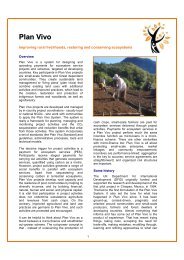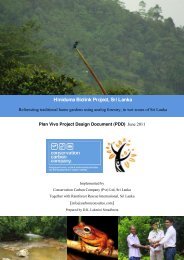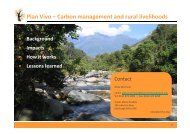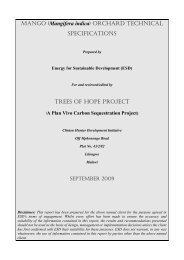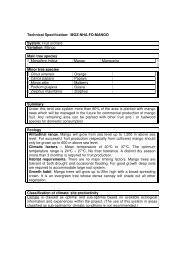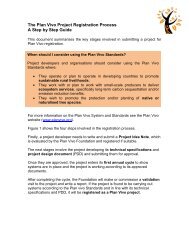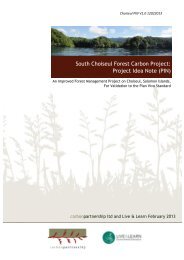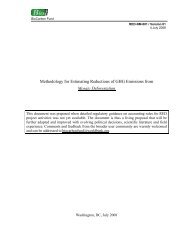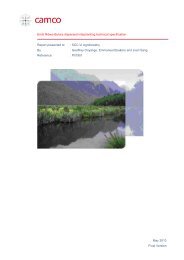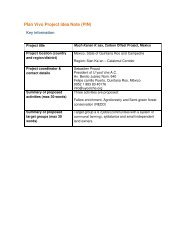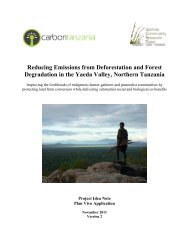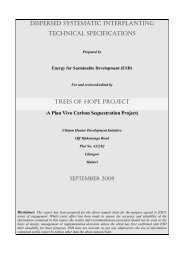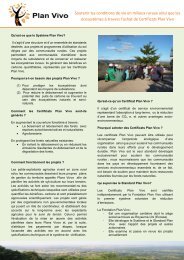Arbres locaux pour un monde meilleur | Local trees for a better world
Arbres locaux pour un monde meilleur | Local trees for a better world
Arbres locaux pour un monde meilleur | Local trees for a better world
You also want an ePaper? Increase the reach of your titles
YUMPU automatically turns print PDFs into web optimized ePapers that Google loves.
16<br />
Comm<strong>un</strong>ity Payments <strong>for</strong> Ecosystem Services in Patako | Plan Vivo PDD 2012<br />
Annual group discussions<br />
Annual meetings will be held between Arlomom and comm<strong>un</strong>ity focus groups as part of the<br />
socioeconomic monitoring. Changes observed during the year will be discussed to <strong>un</strong>derstand the<br />
context and the implications of any changes to socioeconomic conditions.<br />
7 Ecosystem impacts and monitoring<br />
The comm<strong>un</strong>ity areas lie within 2 km of the Patako Forest. The <strong>for</strong>est is a diverse ecosystem with<br />
different vegetation types. These include woody savanna and shrub savanna. The dominant<br />
vegetation type is woody savanna which belongs to the Sudanian Zone of West Africa. There is<br />
relatively high biodiversity in the <strong>for</strong>est, with are approximately 200 tree species (8 of which are<br />
associates of the Guinean domain) and 125 species of birds, which is approximately 20% of the<br />
recorded species in Senegal. The bird population includes; endangered species -‐ Necrosyrtes<br />
monachus, Gyps africanus and Gyps rueppellii -‐ one vulnerable species -‐ (Torgus tracheliotus), and<br />
two near-‐threatened species -‐ Circus macrourus and Falco vespertinus -‐ (IUCN Red Data Book vers.<br />
3.1. 2001). It is home to a number of mammalian and reptilian species including the Western Red<br />
Colobus (Procolobus badius), classified as endangered (EN) by the IUCN Red List of Threatened<br />
Species (2012).<br />
Agro<strong>for</strong>estry activities should increase biodiversity aro<strong>un</strong>d rural comm<strong>un</strong>ities with <strong>trees</strong><br />
f<strong>un</strong>ctioning as habitat islands in an otherwise intensively used landscape. Af<strong>for</strong>estation and<br />
assisted regeneration is designed to abut the Patako Forest, thus extending the <strong>for</strong>est area and<br />
creating habitat network corridors.<br />
As tree cover increases it is anticipated that the ecosystem services of soil conservation and water<br />
availability will be enhanced (Table 5).<br />
Table 5. Summary of expected impacts of project activities on key environmental services<br />
Title of technical<br />
specification<br />
Agro<strong>for</strong>esty –<br />
Intercropping and<br />
bo<strong>un</strong>dary planting<br />
Af<strong>for</strong>estation -‐<br />
plantation<br />
Biodiversity impacts Water<br />
availability/watershed<br />
impacts<br />
Increase biodiversity aro<strong>un</strong>d the<br />
comm<strong>un</strong>ities<br />
Improve the biodiversity aro<strong>un</strong>d<br />
Patako Forest and prevent the<br />
degradation inside the Forest<br />
Protection of<br />
watersheds<br />
Protection of<br />
watersheds<br />
Soil<br />
productivity/conservati<br />
on impacts<br />
Prevention of soil<br />
erosion<br />
Improve soil structure<br />
and fertility<br />
Prevention of soil<br />
erosion<br />
Improve soil structure<br />
and fertility




